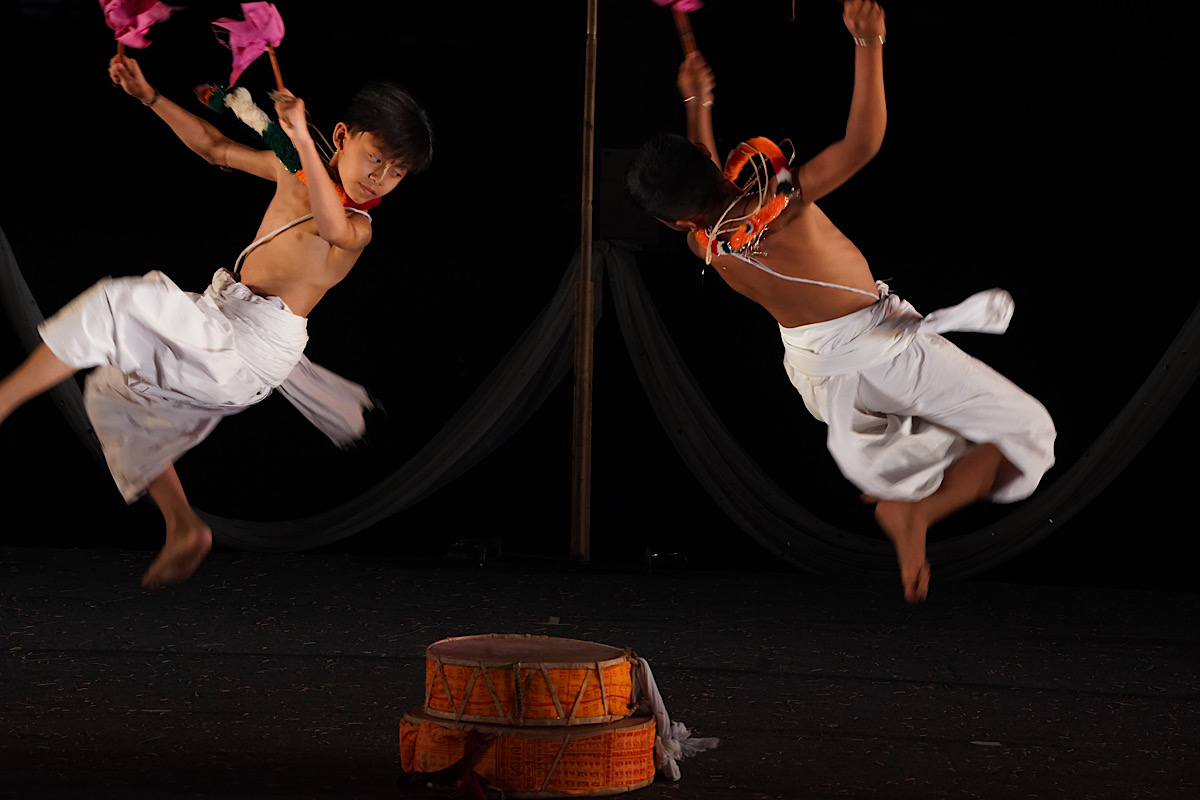Ankur 2024 was a programme by the children to show the different dance and music traditions of Manipur, which they are pursuing. Manipur has a rich legacy of Manipuri dance and music traditions. This legacy has been passed down the ages and is even now being pursued by the young, who are the future. There have been many challenges in the past, and there will be many challenges in the future too. But the people of Manipur have the grit and determination to keep this legacy alive.
Ankur was the joint presentation of Anjika of Priti Patel and Open Doors of Oiendrilla Dutt. Manipuri dance is an ancient form of worship prevalent in the state of Manipur. Its history dates back even before 33 AD. Recently, Anjika presented four forms of dance prevalent in Manipur at the Far Pavilion Lawn of Tollygunge Club. The pre-Vaishnavite forms of Thang Ta and Lai Haraoba and the Vaishnavite forms of Sankirtana and Rasleela are the hallmarks of Manipuri culture, which were presented by young aspirants of Anjika. Yakairol, the first piece, was an invocation from the ancient Lai Haraoba tradition with the accompaniment of the pena, which is a ritualistic musical instrument mentioned in the ancient manuscripts dating back to a time that was before 33 AD. Without the soft, heart-touching strains of the Pena Lai Haraoba rituals, they are incomplete. Like all typical Manipuri The dance presentation Yaikrol commenced with the blowing of the typical double conch shell. The participants were N. Korounganba, A. Lanleima, Th. Lankan Chanu, and Ks.Likla, who trained under the supervision of Mangka Mayanglambam. Prabandha Nartan performed next, followed by a dance of Krishna and Radha from the Rasleela. It was a technical dance based on tala and sargam. The tala was a Tanchep tala of 8 beats. The composition was in the beautiful Tandava style of Krishna and the Lasya style of Radha. Prabandha Nartan was danced by the two very talented sisters, W. Henthoi and W. Gunchenbi, under the supervision of Karuna Devi of Anjika. Dhol Cholom, or the drum dance, was a dynamic dance performed by male drummers. Dhol Cholom, or ‘Drum Dance’ is specially performed during the Holi festival. Dhol Cholom, with its unique style of performing innovative jumps with the dhol hanging down the shoulders of the drummer, was difficult and spectacular. The performances by the young dancers were jaw-dropping. Dhol Cholom was performed by P. Swastik Kumar Sharma, L. Bidyasagar Sharma, H. Manimatum, and L. Yogananda, taught by M. Saitaban Singh of Shree Shree Govindaji Nata Sankirtan.
Advertisement
Thang Ta, or dance with the sword and shield, is a dance that makes you hold your breath each time you see it. The boys wielded their swords dexterously while at the same time shielding themselves from the onslaught of their opponent.
Thang Ta is an ancient martial art of Manipur. This form was at one time used to protect the people from warring tribes and neighbouring countries. At present, it has been revived as a performing art form. S. Mangal, K. Rocker, and S. Gambhir were skilled as they went round and round skillfully. Under the able guidance of L. Sanatombi Devi, S. Robert and Th. Imocha Singh.
The programme, which was being held in the open-air makeshift stage, was practically held up due to black clouds in the night sky drizzling slowly at first and then breaking into large drops, followed by a heavy downpour.
The organisers had the wits about them and changed the venue from The Far Pavilion Lawn to a hall inside the building. What followed was the beautiful Pung Cholom, which was stylized in form and is usually performed as a prologue to the Rasleela. It was amazing to see young male drummers, who were barely in their teens, playing the drums and dancing simultaneously on intricate rhythm and tala patterns. Pung Cholom was performed by P. Swastik Kumar Sharma, L. Bidyasagar Sharma, H. Manimatum, and L. Yogananda, tutored by M. Saitaban Singh (Shree Shree Govindaji Nata Sankirtan). The last piece, ‘Krishna Balya leela’, was an excerpt from the Goshta Leela of Manipuri dance, where the events of the young Krishna were enacted. Incidents of Krishna subduing the invincible serpent king Kaliya during his childhood and the killing of the dreaded Bakasur, or crane demon, sent by King Kamsa to kill Krishna were flawless renditions. The performers W. Henthoi, W. Kunchenbi, K. Khoinou, K. Kambaton, Aparna Roy, S. Robert Meitei, and K. Sushil Singh were epitomes of perfection. All of them were trained by Karuna Devi, K. Ratan Singh, W. Surajkumar, and L. Ratan Singh of Anjika. In spite of the setback caused by untimely rains, the show continued. The readiness of the organisers and the young performers to face any vicissitudes was praiseworthy. The evening was well spent with the very young dancers, full of promises and hopes, who will keep the torch of the culture of Manipuri alive.
Manipuri exponent Priti Patel started teaching dance at the Indian Institute of Cerebral Palsy in 1990. It was the beginning of her journey to discover the wonderful efficacy of dance and movement therapy and the joy it brought to the children. In 1995, she opened her own institute of Manipuri Dance and Movement Therapy, Anjika, which followed an integrated programme of learning. In fact, it was the first school of dance in the country to have this unique programme where all children and adults danced together in spite of their different abilities.
On 16 March at 4.45 p.m. at Raj Bhawan, Oindrila Dutt and Priti Patel paid tribute to the Indian Institute of Cerebral Palsy on its completion of 50 glorious years.
Oindrila Dutt deserves a very special mention. She has quietly and tirelessly worked behind the scenes to bring joy to these children and help in this noble cause.
The writer is a senior dance critic









